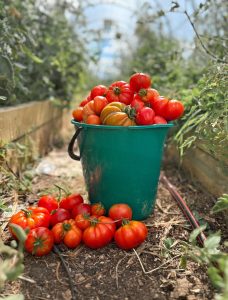MARCH IN THE TUNNELHOUSE – Forging forward!
March in the tunnelhouse
Welcome to Morrifield’s monthly garden guide where we go undercover to bring you the best tips and tasks for great greenhouse growing. March is a month of decision making. In many parts of the country, produce is heading out the greenhouse door by the washing basket load, but the autumn heat won’t keep on going forever. What will you do to prepare for a fresh-food garden over winter and the hungry months of early spring? It’s time to make plans.
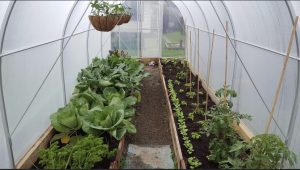
Morrifield’s Gardening Zones
Our long maritime country is filled with exciting microclimates. That means your gardening zone may be quite different to your neighbour’s, just a few kilometres away. Use our simple descriptions to help gauge which undercover zone sounds like you!
Zone 1 (Warm Winters, Hot Summers)
Zone 2 (Mild Winters, Hot Summers)
Zone 3 (Cold Winters, Mild Summers)
Zone 4 (Severe Winters, Hot Summers)
Top Tasks Around the Country
All zones
It’s true that some growers enjoy warmer autumns and winters than others, but we all face a decrease in the number of daylight hours as the world cools down. The growth rate of plants depends on daylight hours, and if you want to make the most of the off-season, it can pay to install grow-lights. (If you do, be sure to have your plans for these checked over by a professional, and installed by an electrician where advised to.) Plants also like a ‘rest’ from light, so do your research, and team your grow lights with an automatic timer so they switch off when required.
Zones 1 & 2
Free seedlings!
Heat loving edibles have now been growing undercover for 7 months or more. That’s plenty of time for plants to have produced tomatoes with viable seed. Some of those tomatoes will have dropped to the ground, unnoticed. As you remove tired leaves from around the base of your plants, check out the soil beneath, and you’ll almost certainly find baby tomato seedlings popping through the soil. These are the seedlings that you can now pot up or coax on where they are, for your winter tomato supply. Feed them a high nitrogen liquid feed, and they’re on their way!
Autumn adjustments
Many pest insects such as psyllids and aphids, don’t die off in the cooler seasons, but the advantage for a winter greenhouse grower is that they are around in smaller concentrations, and so are more manageable with recommended organic sprays. But autumn throws other problems our way. Cooler temperatures mean ventilation must remain all but closed at night, and sometimes during cold days, as well. These ‘lock-down’ conditions are an invitation to downy mildew to make its move, so keep a close watch for it, and treat with homemade baking soda spray at the first sign. Some greenhouse gardeners also find a diluted milk spray can help keep the mildew at bay.
Warm-ups!
The cost of fresh produce continues to skyrocket – to the point where heating your greenhouse over winter may actually be more cost efficient than buying the likes of tomatoes and capsicums (it needn’t be an elaborate arrangement – many growers find that a simple fan heater with thermostat does the trick). If you want to give heating a try, be sure to have a professional check out your proposed system for safety, and ask a qualified electrician to install what you need.
Zone 3
In the mind of many growers in cooler regions, March spells the end of planting the heat-lovers. However, climate-change means that autumn heat can now be more intense, further into the year, than it once was. While it may be too late to grow heat-lovers that take time to produce a harvest, quick growers such as cucumber can still go in the greenhouse now. A cold snap might fell them, but a warm autumn will see them flourish – it’s pays to take a chance. The problem, however, comes when garden centres don’t come up with the goods in autumn, so if you’re having difficulty locating cucumber seedlings for your greenhouse, make a note on your gardening calendar to pop in a few seed in mid-January next year, so you have cucumber plants ready to use at the start of March.
Zones 3 and 4
Going up!
A heated greenhouse over the cooler months is not something many cool region growers can contemplate in terms of cost. However, there are other ways to warm up your undercover space, and one of them is to raise the level of the soil in your greenhouse with built up beds. Built-up beds have the advantage of being free draining, and the less moisture in soil, the warmer it is. If you use heat-retaining materials (such as bricks or concrete) to form the sides of your raised beds, you’ll be helping heat your soil even more. And if you line the beds with black plastic, this will insulate them from the colder soil at ground level. Built up beds are generally more productive that in-ground beds, too. Their looser soil means you can cultivate intensively, and any nutrients you provide are concentrated.
Straw bale success
Not everyone has the skills to create built-up beds in their greenhouse, but we can all aspire to having 2 or 3 straw bales moved into our undercover space over the cooler months. straw bale gardening is a great way to raise the temperature of your growing medium, and by the time you’ve finished using the straw for growing your cool-season veg, it will be breaking down, and be ready to be dug into the soil to support your warm season crop!
Heat sinks
A winter greenhouse can receive loads of warmth on sunny days, but the growth of plants inside can be let down by chilly night time temperatures. To help lock in that lovely warmth from the sun, consider introducing a ‘heat sink’ into your greenhouse. A heat-sink is a natural way of storing up the heat from the sun, and allowing it to release back into the greenhouse at night. Create a heat-sink by moving a large barrel into your greenhouse and filling it with heat-absorbing water. Alternatively, build a low stack of heat-absorbing bricks (safely secured in a cage so they don’t tumble over) in the greenhouse to warm the space after dark. Another option is to have pavers/bricks for your pathway and these will also soak up the days heat and expel during the night.
Sow me undercover now
All zones
Cool season lettuce, spinach, rocket, autumn mesclun mix.
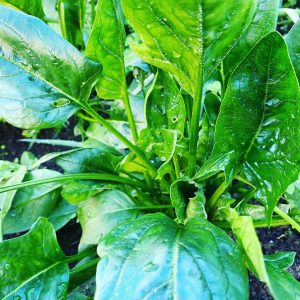
1 and 2
Dwarf beans, carrots, potatoes, spring onion.

Zone 3
Broadbeans, coriander, cucumber, pea shoots, potatoes, perennial silver beet.
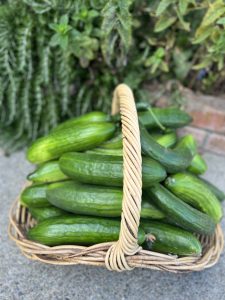
Zone 4
Broad beans, perennial beet, silver beet.

Transplant me undercover now
Zones 1
Basil, cucumber, tomato, zucchini.

Zones 2, 3 & 4
Broad beans, brassica (cauli, cabbage, broccoli, kale), coriander, cool season lettuce, leeks, perennial beet, silver beet.
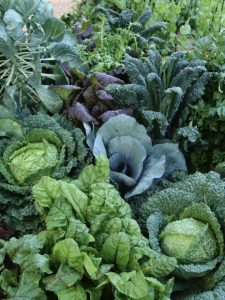
News and views
Check out this harvest from Olivia, her tunnelhouse is certainly producing well!
There is certainly a change in the air as Autumn will be on our doorstep soon…
